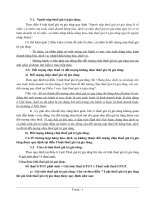Bài giảng BIODIVERSITY
Bạn đang xem bản rút gọn của tài liệu. Xem và tải ngay bản đầy đủ của tài liệu tại đây (4.65 MB, 69 trang )
Bài giảng BIODIVERSITY
INTRODUCTION
The term Biodiversity was first coined by Walter G. Rosen in 1986.
The biosphere comprises of a complex collections of innumerable organisms, known as the Biodiversity, which
constitute the vital life support for survival of human race.
Biological diversity, abbreviated as biodiversity, represent the sum total of various life forms such as unicellular
fungi, protozoa, bacteria, and multi cellular organisms such as plants, fishes, and mammals at various
biological levels including gens, habitats, and ecosystem .
Biodiversity
What does “Bio” means?
Life
Bio =
Biodiversity
What does “Diversity” means?
Diversity = Variety
CONCEPT AND TYPES OF BIODIVERSITY
Biodiversity is the variety of life forms on earth and the essential interdependence of all living things.
As defined in convention on Biological diversity singed at Rio De Jenerio (Brazil) in 1992 by 154 countries,
the Biodiversity defined as “the variability among living organisms from all sources including, inter alia,
terrestrial, marine and other aquatic eco-systems and the ecological complexes of which the area part- this
include diversity with in species, between species and of ecosystem.”
According to IUCN in 1998, “the variety and variability of species of their population, the variety of
species of their life forms, the diversity of the complex association with species with their interaction and
their ecological process which influences perform.”
There are three types of biodiversity
Diversity of Species
Diversity of Ecosystem
Diversity of Genes
Species diversity
•The number or variety of
species in a particular region
•Species richness = number of species
•Evenness, or relative abundance = extent to which numbers of different species are equal
or skewed
•Species = a particular type of organism; a population or group of populations whose
members share certain characteristics and can freely breed with one another and produce
fertile offspring
Figure 15.2
Ecosystem diversity
•Includes diversity
above the species
level
•Biologists have viewed diversity above the species level in various ways. Some
alternative ways to categorize it include:
»
»
»
Community diversity
Habitat diversity
Landscape diversity
Figure 15.2
Genetic diversity
Includes the differences
in DNA composition
among individuals
within a given species
•Adaptation to particular environmental conditions may weed out genetic variants that
are not successful.
•But populations benefit from some genetic diversity, so as to avoid inbreeding or disease
epidemics.
Figure 15.2
DISTRIBUTION OF BIODIVERSITY
Flora and fauna diversity depends onClimate
Altitude
Soils
Presence of other species
Most of the biodiversity concentrated in Tropical region.
BIODIVERSITY AND BALANCE OF NATURE
Tropic Level: Elimination of species from tropic level can
cause destruction of ecosystem as well as
biodiversity.
Plants in forest
Complex Ecosystem: In a complicated ecosystem having several
tropic levels, loss of one or more spices do not
cause any serious problem because the alternative available.
Keystone Species: Loss or addition of species causes detectable
changes in ecosystem rates i.e. species make unique
contribution to ecosystem functioning.
Niche Complementary: Difference among species in their
complementary
requirements for different resources will cause
interaction so that a species could obtain more resources.
Facilitation and Mutualism: Plants may also benefit from
of the physical
and biotic environment.
Portfolio Effect: Species richness increases the temporal
while the biomass is
warming.
stability of the entire community
stabilized.
Insurance Hypothesis: Biodiversity buffers ecosystem
global
their neighbors through amelioration
against environmental changes such as
Benefits of biodiversity
•Preserving biodiversity preserves ecosystem services, and directly provides things of pragmatic value to
us.
–
–
–
–
–
–
–
–
–
–
•
Food, fuel, and fiber
•
Shelter and building materials
•
Air and water purification
•
Waste decomposition
•
Climate stabilization and moderation
•
Nutrient cycling
•
Soil fertility
•
Pollination
•
Pest control
•
Genetic resources
Benefits of biodiversity: Food security
Many species not now commonly used
for food could be. .Genetic diversity
within crop species and their relatives
enhances our agriculture and provides
insurance against losses of prevalent
strains of staple crops.
Figure 15.11
Benefits of biodiversity: Medicine
•Many species can provide novel
medicines; we don’t want to drive
these extinct without ever discovering
their uses.
•Ten of our top 25 drugs come
directly from wild plants; the rest we
developed because of studying the
chemistry of wild species.
Figure 15.12
Forest and their Uses
General Use
Maintaining the water supply
Maintaining the water supply
Forest:
•
•
•
Enable water to be collected and stored within a water catchment
Eg: Bukit Timah Nature Reserve
Consists of 4 reservoirs surrounded by forests
Maintaining the water supply
•
Forest forms part of the water cycle:
– Process of evapo-transpiration
– Water released into the atmosphere
– Encouraging Cloud formation, condensation and rain
– Rain falls replenishes the water in rivers and reservoirs
– Leaves/branches intercept water and water seeps into the ground as groundwater
– Reducing surface-runoffs
Maintaining water quality
•
•
•
Supports natural filteration
Makes its possible for drinking and supporting life
As the water flows seeps into the ground, soil particles trap impurities and filters
the water
•
Less run-offs reduce erosion of soil and deposited in reservoirs and rivers
Maintains the Nutrient
cycle
•
Keeps the soil
fertile
Replenishing Oxygen and Removing Carbon Dioxide
•
Forest as Green Lungs of the Earth:
–
During photosynthesis, trees and plants
give off oxygen and take in carbon dioxide
to make food
–
Reduction in carbon dioxide content
prevents rising global temperatures
Nutrients on the forest floor





